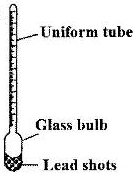Questions
- State how a hydrometer may be used to test whether a car battery is fully charged.
- Determine the density of glass that weighs 0.5N in air and 0.3N in water.
- A mass of 120g half immersed in water displaced a volume of 20cm3.
Calculate the density of the object. - A solid displaced 5.5 cm3 of paraffin when floating and 20cm3. Calculate the density of the object.
- The figure below shows a cube of a certain wood whose density is the same as that of water. The cube is held on the surface of the water in a long cylinder.
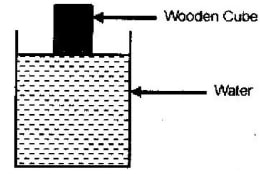
Explain what happens to the cube after it is released. - A right angled solid of dimensions 0.02m by 0.02m by 0.2m and density 2,700kg/m3 is supported inside kerosene of density 800kg/m3 by a thread which is attached to a spring balance. The long side is vertical and the upper surface is 0.1m below the surface of the kerosene.
- Calculate the force due to the liquid on the lower upper surface of the solid.
- Calculate the up thrust and determine the reading on the spring balance.
- A solid copper sphere will sink in water while a hollow copper sphere of the same mass may float. Give a reason for this.
- A uniform plank of wood is pivoted at its centre. A block of wood of mass 2kg is balanced by a mass of 1.5 placed 30cm from the pivot as shown.
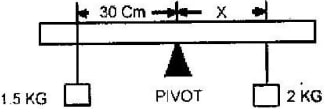
- Calculate the distance X
- When the same block of wood is partially immersed in water, the 1.5kg mass need to be placed at 20cm from the pivot to balance it. Calculate the weight of the water displaced.
- A block of glass of mass 250g floats in mercury. What volume of the glass lies under the surface of the mercury? (Density of mercury is 13.6 x 103).
- When a piece of metal is placed on water, it sinks. But when the same piece of metal is placed on a block of wood, both are found to float. Explain this observation.
-
- State the law of floatation. (1mk)
- The figure below shows a simple hydrometer.
- State the purpose of the lead shots in the glass bulb (1mk)
- How would the hydrometer be made more sensitive? (1mk)
- Describe how the hydrometer is calibrated to measure relative density. (2mks)
- The figure below shows a cork floating on water and held to the bottom of the beaker by a thin thread
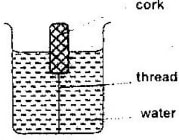
- Name the forces acting on the cork. (3mks)
- Describe how each of the forces mentioned in (i) above changes when water is added into the beaker until it fills up. (3mks)
- The ball B shown below has a mass of 12kg and a volume of 50litres. It is held in position in sea water of density 104 kgm-3 by a light cable fixed to the bottom so that 4/5 of its volume is below the surface determine the tension in the cable.
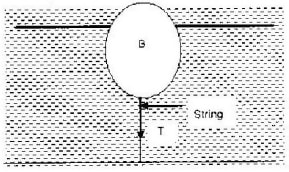
- A balloon of volume 1.2x107 cm3 is filled with hydrogen gas of density 9.0 x 10-5/g/cm3. Determine the weight of the fabric of the balloon.
- A boat whose dimensions are equivalent to those of a rectangular figure of 5m long by 2m wide floats in fresh water. If this boat sinks 10cm deeper as a result of passengers climbing on board, determine the total weight of these passengers.
- One fifth of the volume of an iceberg stands above the water surface. If the density of the seawater is 1.2g/cm3, determine the density of iceberg.
- A hydrometer of mass 10g is placed in paraffin of density 0.8g/cm3. Determine the length of the paraffin if its bulb has a volume of 4cm3 and its stem has a cross section area of 0.5 cm2
- An object of mass 50g floats with 20% of its volume above the water surface as shown below. The tension in the string is 0.06N.
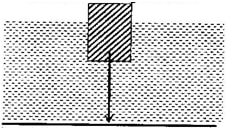
- Calculate the up thrust experienced by the object.
- Volume of water displaced.
- The density of the object
- What would happen if the string was cut?
- A piece of marble of mass 1.4kg and relative density 2.8 is supported by a light string from a spring balance. It is then lowered into the water fully. Determine the up thrust.
- The block of wood of mass 80g is pulled just below the water surface by a piece of copper of density 9 g/cm3 using a string of negligible weight. What is the mass of the piece of copper?
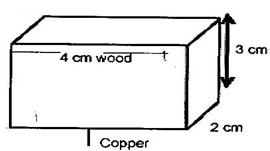
- If the body weight 1.80N in air and 1.62N when submerged in a liquid of relative density 0.8, find
- the volume of the solid.
- The density of the solid
Answers
- Place it in the acid and read at the level of the acid surface. In a fully charged car battery, should read 1.25.
- Volume of glass = Volume of water displaced
= (0.2 ÷ 103) kg
g
Mass of glass = 0.5/g
Density of glass = m/v
= 0.5 ÷ 0.2 x 1
g g 103
= 2.5 x 103 kg/m3
= 2500 kg/m3 - Volume of the object = Volume of water displaced
Density of object = Mass = 120 = 3 g/cm3
Volume 40 - Mass of paraffin = Mass of solid = vol x dens
= 5.5 x 0.8 = 4.4g
∴ Density of solid = Mass = 4.4 = 0.22g/cm3
Vol 20 - Metal is denser than water. Metal and the piece of wood have a general density (combined density) less than that of water and floats just below the surface.
-
- Lower surface of solid
P = gh
Force = P x A = gh x A
= 800 x 10 x 0.5 x 4 x 10-4
= 0.96N
Upper surface of solid.
Force = P x A = gh x A
= 800 x 10 x 0.1 x 4 x 10-4
= 0.32N - Upthrust = 0.96 – 0.32 = 0.6N
Weight of the solid = Density x Volume x g
= 2.7 x 103 x 0.2 x 10-4 x 4 x 10
= 2.16
Balance reading = 2.16 – 0.64
= 1.52N
- Lower surface of solid
- Solid copper is denser than water hence the solid sphere sinks, weight is greater than upthrust. Hollow sphere experiences an upthrust equal ti its weight so it will float/density of hollow sphere is less than that of water i.e. volume of water displaced is a lot more than the weight of the sphere.
-
- Clockwise moments = Anticlockwise moment.
2.0g x = 1.5g x 30
2x = 45
x = 22.5cm - Down force:
M x 22.5
= 20 x 1.5
M = 30/22.5 = 1.33Kg
Upthrust = 0.67Kg.
Therefore weight of water displaced = 6.7N
- Clockwise moments = Anticlockwise moment.
- Weight of block = Weight of mercury displaced or law of floatation.
0.250 Kg = V x 13.6 x 103
V = 0.25 = 1.838 x 10-5m3 = 18.38m3
13.6 x 103 - The weight of the metal is more than he upthrust but the metal block together with wood displace their own weight (upthrust) hence the two float in water
-
- A floating body displaces its own weight of the liquid on which it floats.
-
- To enable the hydrogen float upright.
- Float hydrometer on water and on liquid of known density in turn and mark levels/divide proportionally and extend on either side.
-
- Tension, upthrust, weight.
- As water is added, upthrust tension increases weight remains unchanged as water is added.
- 296N
- 14.52 kg
- 1000 Kg
- 0.969 g/cm3
- 17cm
-
- 0.56N
- 70cm3
- 0.7143g/cm3
- It would move up until it displaces its own weight.
- 5N
- 3.33g
-
- 22.5cm3
- 8g/cm3
Join our whatsapp group for latest updates
Tap Here to Download for 50/-
Get on WhatsApp for 50/-
Download Floating and Sinking Questions and Answers - Physics Form 4 Topical Revision.
Tap Here to Download for 50/-
Get on WhatsApp for 50/-
Why download?
- ✔ To read offline at any time.
- ✔ To Print at your convenience
- ✔ Share Easily with Friends / Students

